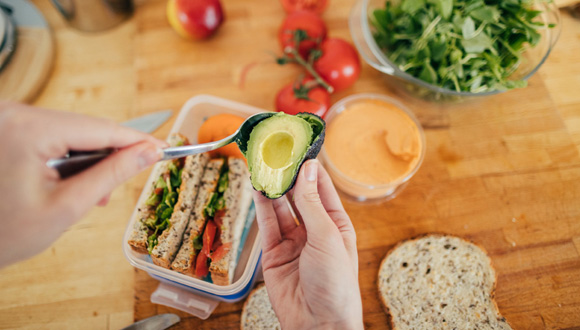The 5 Principles to Making an Easy Lunch That's Also Healthy & Filling
Dec. 11, 2020 - Kylie ArrindellLunch is an important midpoint to your day. What you choose to eat can set you up for success, or it can set you up for failure.
A poorly planned lunch can result in you consuming excess calories, sugars and fat — which may be followed by an energy crash a couple of hours later. Conversely, a well-balanced lunch can leave you feeling satisfied and help you avoid the late-afternoon energy slump.
In addition to improving your mood and energy levels, a well-balanced lunch can also help:
- Regulate your hunger level into the late afternoon
- Reduce your chance of overindulging at dinner
- Ensure you make healthy lifestyle decisions for the rest of the day
Plus, if you have an efficient routine, prepping a well-balanced lunch isn't much more work than throwing together an unhealthy one.
The 5 principles to an easy, healthy lunch that's also filling
Instead of "winging it" again for lunch all week, consider following these simple steps to making easy lunches that are filling and healthy:
1. Have a plan for a healthy lunch
The first big mistake when it comes to lunch is often a lack of planning. Running out your door in the morning without any idea of what lunch might look like can set you up for making some bad decisions come lunchtime. If you do leave home without a plan, don't wait until you're starving to decide what to eat for lunch! This is almost always a recipe for an impulsive, all-to-convenient option that tends not to be the healthiest.
To set yourself up for lunchtime success, plan ahead. I recommend deciding the night before — or, better yet, even earlier in the week — what your lunch plan might look like. This will ensure that you have thought about the components of a well-balanced lunch and have the time to get your lunch together.
For the work-from-homers out there, avoid the temptation to make lunch on the fly. Even though you have easy access to your fridge and pantry, planning ahead is still the most ideal way to ensure your easy lunch stays healthy.
2. Balance your midday meal
Any well-balanced meal — lunch included — consists of lean protein, fiber-rich sources of carbohydrate and veggies, and healthy fats.
The typical lunchtime staple of a sandwich can be made into a well-balanced meal if you include:
- 100% whole grain bread
- Fresh deli turkey or leftover grilled chicken
- Plenty of veggies, such as spinach and other leafy greens, tomato, onion and sliced bell peppers
- A few slices of avocado
A mixed dark green leafy salad is another great idea for lunch. You can make it your own by topping it with:
- Plenty of other veggies (bonus points for multiple colors)
- Tuna, salmon or tofu
- Homemade dressing on the side or freshly sliced avocado
- Whole grains such as cooked farro or quinoa
3. Check your lunchtime portion size
Portion sizes that are too large can also be a culprit in an unhealthy lunch. That being said, however, everyone has different levels of activity and, therefore, calorie needs. To keep your portions in check, it helps to know what a healthy lunch portion looks like for you:
- If you're very active, and especially if you work out in the late morning, you may need a higher-calorie lunch to help replace glycogen stores and facilitate muscle recovery.
- If you're less active, you may need a lunch with fewer calories.
- If you prefer to eat small meals or larger snacks throughout the day, your portion sizes will need to adjust as appropriate.
If the portion size or calorie-content of your lunch seems a little large or high, respectively, don't despair! Step 4 can help.
4. Make food substitutions, if needed
No surprise here, but visually thinking of the well-balanced meal components mentioned above and comparing these to what you're wanting to eat for lunch can help you determine where you might be going wrong.
If you notice some unhealthy ingredients, there's almost always a substitution you can make to help decrease the amount of unhealthy components.
Too much fat? Try decreasing the portion size or swap out saturated fat for a heart-healthy unsaturated fat.
Not enough veggies or fiber? Get creative and add in nonstarchy, colorful veggies, such as tomatoes, cucumbers, red bell peppers, carrots, zucchini and mushrooms, or fruit. Or, consider a whole-grain side dish, such as quinoa.
For example, salads can quickly become calorie-rich and unhealthy when toppings go overboard. Adding cheese, bacon, croutons and a high-fat dressing can quickly turn a 300-calorie salad into three or four times that. Make your salad healthier by swapping cheese with avocado, bacon with tuna or turkey and croutons with nuts or seeds.
Lastly, prepackaged items — while convenient — should be carefully considered and weighed against the well-balanced meal components listed earlier, as these can often take you over a standard portion size and are usually not the healthiest options as compared to whole foods.
5. Rethink your lunch sides
After putting in the work to make a well-balanced lunch, the last thing you want to do is add in a side dish that undoes a lot of your healthy effort.
The typical sides to lunches — such as chips, pretzels, granola bars and other high-fat packaged items (or products with a lot of added sugar) — should be swapped with whole, nutrient-rich options like a handful of nuts, a cup of mixed fruit, a piece of mozzarella cheese or an extra veggie.








